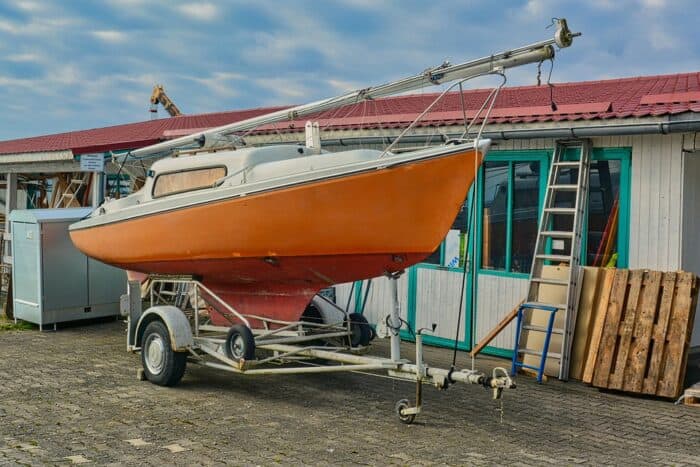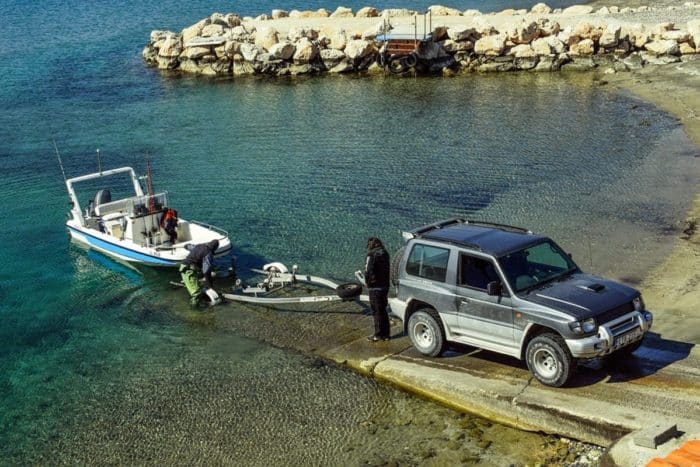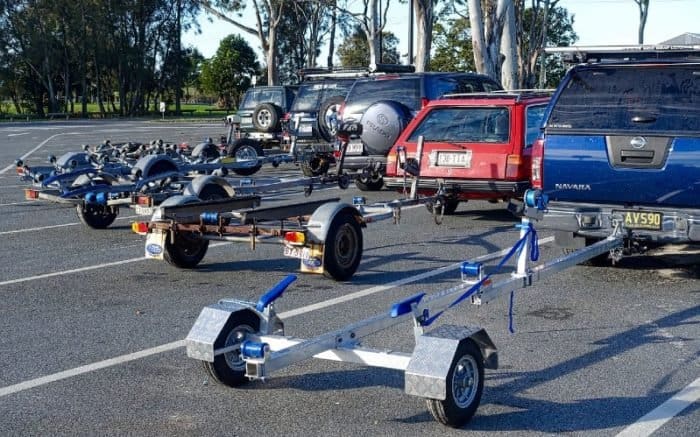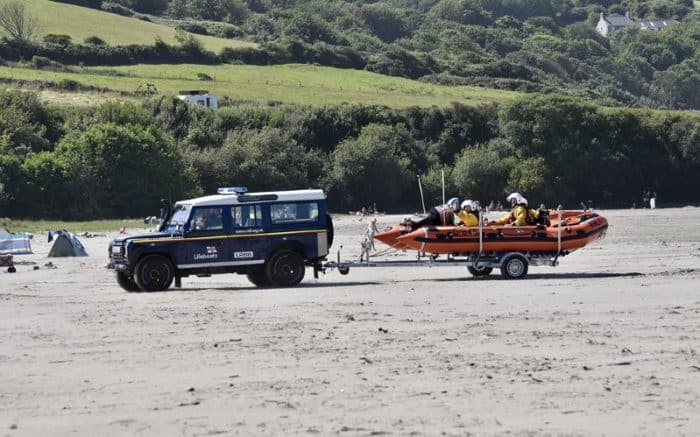How Do Surge Brakes Work on a Boat Trailer?
Surge brakes are one of several kinds of brakes that a boat trailer may have. Surge brakes are a kind of hydraulic brakes and arguably the simplest and easiest to both use and understand of the brakes a trailer might employ. The process of braking your tow vehicle will cause the trailer’s momentum to push forward on the hitch. There is a master cylinder inside the front end of the trailer and, when you brake, it forces a rod against the cylinder. This increases the pressure of the liquid in the brake lines, forcing the calipers to squeeze the brake pads on your trailer’s wheels and that in turn stops the trailer. Hydraulic brakes are some of the oldest style brakes there are and your own car’s brakes likely work in much the same fashion. They may be either disc brakes or drum brakes, the brake system is much the same for each.
Parts of Hydraulic Surge Brakes
The basic functioning of your surge brakes is not all that complicated. These have long been the preferred brakes of trailers because they are simple, don’t require additional power, and they work well in water. This is perhaps their greatest advantage over electrical braking systems. You don’t need to worry about water, and especially salt water, damaging and corroding any electrical systems. Let’s take a closer look at how it all works.
Tow Vehicle
The brakes in your trailer essentially start in the tow vehicle itself. Your brakes set the tone for the trailer brakes because the trailer brakes only work when you brake the tow vehicle. The connection is a physical one that occurs in the coupler
Hitch or Coupler
This is where the transition of energy occurs from tow vehicle to trailer. Not electrical energy, or air pressure, or anything like that. The genius of surge brakes is how they use simple physics.
The neck of your trailer is in two parts. The first half is where the coupler is and it attaches to your vehicle. The back half is where the master cylinder is located. A rod connects the two. When the trailer is in motion, these two sections pull apart as your tow vehicle pulls the trailer forward. But as you brake and slow, the momentum of the trailer and its weight force the two sections together again. That’s what makes the rod push back into the master cylinder.
Cylinder and Brake Fluid
Without getting too heavily into concepts like differential pressures and rates of deceleration, what basically happens when you brake is that a rod applies pressure to the master cylinder. This compresses the cylinder and then increases the pressure of the brake fluid that makes up the hydraulic system. This increased pressure is then transferred forward and the brake fluid flows towards the calipers and pads which forces them to tighten. When you ease off the brakes, the two parts of your trailer tongue are able to pull apart again. This releases the pressure by allowing the rod to pull away from the cylinder.
Calipers and Pads
The calipers in your trailer brakes are like clamps. When the pressure in the lines increases it forces the calipers to squeeze down and that puts pressure on the brake pads. The pads then squeeze the rotor in your trailer wheel. This pressure forces the wheel to slow down because it’s holding it tightly and creating friction. The more pressure, the more stopping power. Just like in your car, over time, the friction can cause damage to those pads and wear them down. Over time they will become less effective at stopping the trailer.
4 or 5 Pin Connector
If you have a newer trailer then it will also have an electrical connection which features four or five pins attached to it. This connection allows for the operation of the brake lights on your trailer when connected to your tow vehicle as well as running lights and turn signals, but that’s not all. In newer trailers, the fifth pin will connect to a solenoid valve inside of the coupler. When you reverse, that solenoid locks the brakes so they can’t engage. It only works when you’re in reverse, and it prevents the hydraulic fluid from flooding the lines and clamping those calipers down, ensuring a much easier time backing up.
If you don’t have this kind of connection, a pin needs to be inserted into the neck of the trailer to provide the same function of preventing the brakes from clamping down as you move the vehicle and trailer backwards. This is an extra step that is a bit of a minor inconvenience but when balanced against the cost of repairing older electric brake systems, it’s not that much of an issue.
The pin performs the same function as the solenoid and when it’s in place, the cylinder is unable to increase the fluid pressure and activate the brakes. Since the tongue is in two parts, the pin is just a mechanical stop gap that prevents them from coming together when you back up. It’s a simple but effective solution that means the rod can’t push back into the cylinder.
Don’t worry if you forget to place the pin at first as it’s likely almost everyone who has used a boat trailer has done this at least once. All that will happen is that you’ll force the trailer to brake and as soon as you realize you aren’t backing up, you’ll probably remember to get out and put the pin in place.
How Surge Brakes are Different From Other Brakes
Trailers usually have one of three styles of brakes. Surge brakes, as we’ve seen, are the standard type of brakes for a boat trailer. There are also electronic braking systems and also air brakes. Air brakes are reserved for larger vehicles and wouldn’t typically apply to anything you’re likely to use. But it’s not impossible to find electronic braking systems in a few boat trailers.
Thanks to some much higher quality heat shrink connectors and wiring insulation, electric brakes are becoming more common in boat trailers. For that reason, you do need to make sure you know if you’re dealing with electric brakes or a surge brake when you get a trailer, especially if it’s a used one that may not have all the features spelled out for you.
The main difference between electric and hydraulic brakes in terms of performance is time. Electric brakes are activated immediately when you put your foot in the brake in the tow vehicle. Surge brakes can’t respond that quickly, however. When you brake with surge brakes the tow vehicle has to slow, the trailer tongue parts need to compress, the rod then transfers the pressure to the cylinder and the brakes are activated as a result. That’s still a fast process, it happens in moments, but it does have a small lag between when you brake and when the trailer brakes as a result. That makes braking with a traditional trailer and surge brakes more of a careful process.
You need to give yourself more time and more room to use surge brakes than you might with electric brakes. Given that you may be hauling as much as 10,000 pounds on your trailer, this is certainly reasonable. Always use caution when braking and towing a trailer.
What Are Electric Over Hydraulic Brakes?
Electric Over Hydraulic or EOH are just electric brakes but with a more specific name. Despite the electric part, they are very similar to the surge brakes on your trailer because both use hydraulics to allow for the brakes to function. The only difference is that in electric over hydraulic brakes an electrical signal is what causes the cylinder to increase hydraulic pressure and activate the calipers. In traditional surge brakes it’s the force of the rod pressing on it.
Maintaining Surge Brakes
Because surge brakes work in a self-contained system, there’s not a lot of maintenance needed to keep them running. That’s part of the reason they’re so popular, in addition to their ease of use in the water.
Like the brakes in your car or truck, the surge brakes in your trailer will need some minimal upkeep and probably only every few years at most. Like car brakes, the brake pads can and will wear out eventually and need replacement. If you hear them squealing or making grinding noises, consider having the pads inspected and replaced.
If the brakes are not responding as they should, you may also have developed air bubbles in the brake lines. That can require bleeding to clean them out and then the addition of new fluid. Likewise if brake fluid levels decrease in a brake line it can limit your braking force and be potentially dangerous. This can be a DIY project but make sure you know what you’re doing and that you have the right kind of brake fluid as a replacement. It’s likely a DOT 3 fluid, but double check with the details from the manufacturer.
The Emergency Breakaway System
As a safety measure, boat trailers are equipped with an emergency breakaway system. This is a line or chain that connects tow vehicle to trailer. In the event that the trailer comes away from the tow vehicles, the chain or line activates the surge brakes to stop the trailer load from flying free.
The Bottom Line
Surge brakes are mechanical brakes that can safely be used in water which makes them ideal for boat trailers. They work by allowing the momentum of the trailer itself to compress a master cylinder inside the trailer tongue when you apply your brakes in the tow vehicle. The hydraulic cylinder then increases the pressure in the brake lines, clamping the calipers and brake pads down on the drums or rotors in your trailer wheels, bringing them to a stop.
Surge brakes are a very efficient kind of braking system and don’t require a ton of maintenance. They work well even with large trailers and boats, but they do require a bit of caution when using. There is a small lag time between when you brake the tow vehicle and then the surge brakes will be able to brake the trailer. For that reason, always make sure you give yourself enough time and space to apply the brakes when towing a boat trailer.
Categories: Boats
















